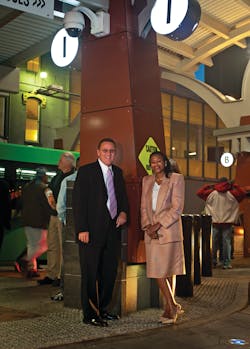At the Greater Dayton RTA, safety and security of passengers, employees and assets is a top priority.
So when the agency was given a chance to have its security standards assessed by the Transportation Security Administration, it was an opportunity leaders there said they couldn’t pass up.
“We wanted an honest assessment. We wanted a third party to come in and take a look at our situation and give us an honest assessment,” said Jim Napier, director of safety, security and training for RTA. “As they saying goes, the more you know, the more you can grow.”
GDRTA took part in the TSA’s Baseline Assessment for Security Enhancement (BASE) program. The voluntary program involves having TSA officials give a comprehensive review of transit agency security and identifies areas for possible further enhancement in 17 different categories, such as planning and education.
Napier said the week-long assessment was rather intense because as security professionals, the agency wanted to demonstrate it was thoughtful about protecting employees, riders and assets.
“This really tests you mentally in terms of preparedness and ongoing efforts to enhance safety,” he said.
Napier and other Dayton security officials discovered they had been doing a great job preparing the agency and were awarded the gold standard in the BASE assessment, which is the highest achievement an agency can get through the program. However, even with the high mark, Napier said TSA reviewers were still able to find more area for improvement.
“First let me say this: there are just some areas of risk that we manage to the best of our ability so we’re never going to reach perfection,” he said. “But a couple of learning points were we learned we needed to start up a security auditing process, we needed to double check ourselves and what we’ve done, so we added a position, a security systems analyst, to our team.
“That was a great takeaway and the person who was put in this position, this individual in charge has really been stepping up.”
The audit process has also helped in identification of training and Napier said RTA will bring active shooter training to the agency in the next several months.
Besides the knowledge gained from the assessment, Napier said it also helped the agency grow its relationship further with TSA. He said the agency had a relationship with TSA for the last four years and going through the assessment has strengthened the relationship.
“Going through the process, there’s a lot of dialogue, so we definitely trust their security expertise,” he said. “We’re confident these folks are only a phone call away if we need any kind of assistance whether it be information or boots on the ground with the viper operations.”
Napier said the RTA will participate in the assessment in future cycles and recommended other agencies do the same.
“The more you know about your strengths and weaknesses, the better equipped you are to respond and to develop workable solutions,” he said.
About the Author
Joe Petrie
Associate Editor
I came to Mass Transit in 2013 after spending seven years on the daily newsbeat in southeastern Wisconsin.
Based in Milwaukee, I worked as a daily newspaper reporter with the Waukesha Freeman from 2006-2011, where I covered education, county and state government. I went on to cover courts for Patch.com, where I was the main courts reporter in the Metro Milwaukee cluster of websites.
I’ve won multiple awards during the course of my career and have covered some of the biggest political events in the past decade and have appeared on national programs.
Having covered local government and social issues, I discovered the importance of transit and the impact it can have on communities when implemented, supported and funded.

